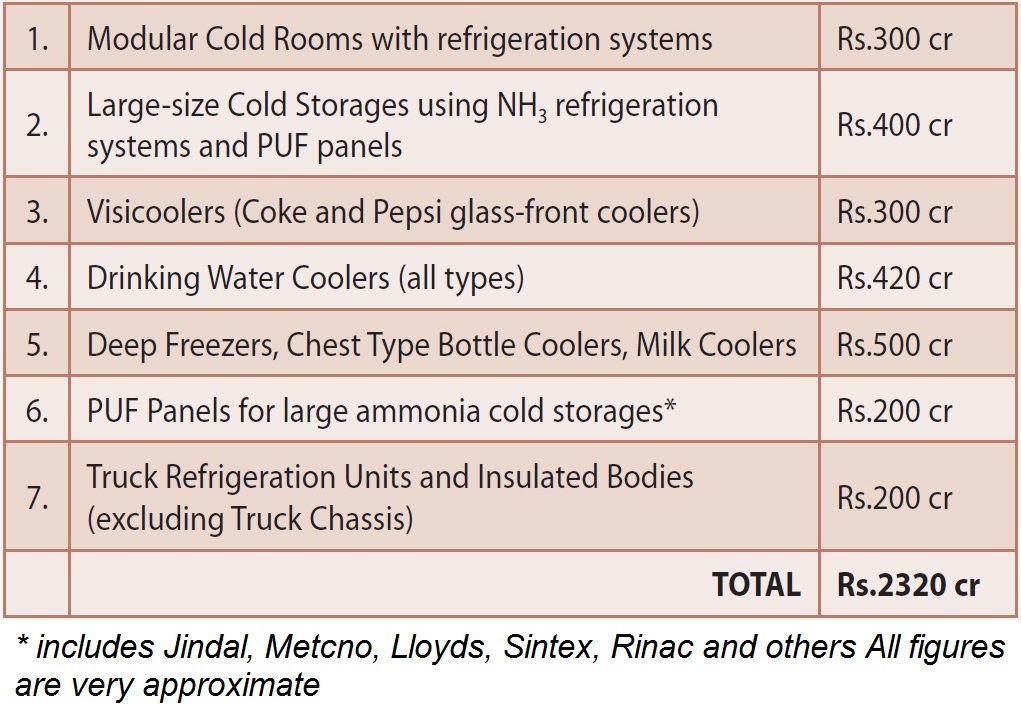News Details
The Size of the Cold Chain Market in 2013-14
10 September 2014
The Cold Chain has been growing at 20-25% year-on-year for several years. In 2013, the growth slowed down to about 10-12% as per estimates from a few major companies in the field, due to uncertainties in the economy, the national elections and the formation of a new government at the Centre. In 2014, the growth is expected to resume based on market sentiment and greater confidence in the decision-making process at the Centre. Refrigeration engineers and companies involved in this field are already aware that the Cold Chain is made up, as far as they are concerned, of a variety of refrigeration machinery/ equipment for large cold storages comprising ammonia refrigeration system and PUF insulated panels with doors, which are field installed, and factory fabricated cooling appliances such as deep freezers, drinking water/bottle/milk coolers, food display cases and modular cold rooms with self-contained cooling systems or with unit coolers and remote condensing units. In addition, transport refrigeration units and insulated bodies all mounted on a truck chassis, make up the Chain. It is logical to estimate a Rupee value against each item and arrive at a total Rupee value of all the cooling equipment required for the Cold Chain. This study includes the following major items and the list has been enlarged to make it as comprehensive as possible. Further refinement is certainly possible and all numbers are very approximate.
Prospects for 2014-15: Based on many tell-tale signs and holistic industry intelligence reports that are listed below, the prospects appear excellent.
Reliance Retail, the country’s largest retailer from groceries to consumer electronics, with revenue of Rs 14,496 cr in the year ended March 2014, sees retail as a big growth engine. Mukesh Ambani, Chairman RIL, at their AGM recently in Mumbai, has said that they are investing heavily in expanding this part of their business. Presently, they have 1691 stores, which occupy 12 million sq ft of space.
Tesco of UK is the first supermarket chain to receive all government approvals in its JV with Tata Group’s Trent, making it the first FDI in multi-brand retail since the Modi government was formed. A lot of advance planning and work has already been carried out in Bengaluru, involving the installation of refrigeration equipment.
Changing eating habits are not only fuelling expansion and growth of quick service restaurants (QSRs), but also the growth of the cold chain logistics industry, like Kelvin Cold Chain, Gati, Crystal Logistic and Snowman. Kalpataru is about to complete the first of its cold chain warehouses. These companies help distribute food from centralised kitchens to QSR outlets where minimal cooking takes place, and all of them are seeing a large growth in their business from this source. Gati, for instance, has seen a growth of 25-30% in the last few years.
Refrigeration equipment manufacturers such as Star Coolers & Condensers in Jalgaon and Emerson Climate in Pune, both in Maharashtra, who are in day-to-day touch with cold storage owners, designers and installers are introducing new equipment to keep up with the market trends. Star C&C started 15 years ago concentrating on Unit Coolers with a humble first year turnover of Rs.50 lakhs. Today, they are the largest producers of Unit Coolers with a turnover of close to Rs.40 crores. Two years ago, they added a line of IQ Freezers and Evaporative Condensers that have received a warm welcome from end users. Emerson’s Copeland has introduced air-cooled condensing units in the 1-40 hp range, for the first time, for use in commercial refrigeration applications for cold rooms and cold storages.
Revised funding schemes from MIDH (Mission for Integrated Development of Horticulture from the central government) to boost cold chain infrastructure will now be available for multi-chamber cold storage units with sophisticated technologies that are energy efficient with provision for thermal insulation, humidity control and automation and standards approved by the government. Initially, subsidies were given to the owners and promoters and were eventually deployed for personal use. Under the MIDH scheme, such misuse will be reduced as subsidies are linked to technical standards and an audit system enforced by NHB. The proper window for availing subsidies has also been clearly identified to prevent earlier confusion in the mind of the entrepreneur. And finally, a story in this issue illustrates how the growth of the Cold Chain is changing the face of the country. Pimpalgaon in Nashik District of Maharashtra exported 6,500 forty-foot containers of grapes last year. There are as many as 270 small and large cold storages in the area complete with Pack Houses. The town is full of large homes of farmers with a couple of cars parked in each compound. Sankara Subramanian, a refrigeration expert from Mumbai decided to move to Pimpalgaon along with two partners, to provide a next-door presence, a complete package of ready stock of spares and refrigerant, expertise to provide 24x7 breakdown service during the busy export season as well as the ability to design/install new cold storages for their expansion projects.
(For the full story, see page C13 of COLD CHAIN July-Aug’14 issue)
Disclaimer: The information provided within this publication / eBook/ content is for general informational purposes only. While we try to keep the information up-to-date and correct, there are no representations or warranties, express or implied, about the completeness, accuracy, reliability, suitability or availability with respect to the information, products, services, or related graphics contained in this publication / eBook/ content for any purpose. Any use of this information is at your own risk.
 Youth
Youth
 Women
Women
 Research for Ishrae
Research for Ishrae







